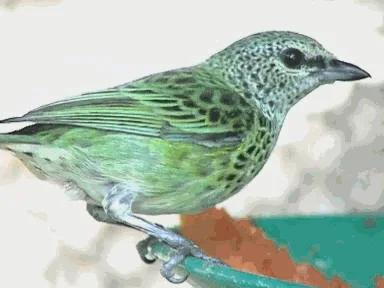
Spotted Tanager
[order] PASSERIFORMES | [family] Thraupidae | [latin] Tangara punctata | [UK] Spotted Tanager | [FR] Tangara tachete | [DE] Drosseltangare | [ES] Tangara Goteada | [NL] Druppeltangare
Subspecies
| Genus | Species | subspecies | Breeding Range | Breeding Range 2 | Non Breeding Range |
| Tangara | punctata | SA | Amazonia | ||
| Tangara | punctata | annectens | |||
| Tangara | punctata | perenensis | |||
| Tangara | punctata | punctata | |||
| Tangara | punctata | punctulata | |||
| Tangara | punctata | zamorae |
Physical charateristics
Upperparts are mainly bright green with black spots. The face and throat have a blue-grey tinge while underparts are white with large black spots and the flanks are yellow-green with black spots. Both sexes are virtually identical except that the colour of the female is a little washed out compared to the cock and the black flecking is less prominent.
Listen to the sound of Spotted Tanager
[audio:http://www.aviflevoland.nl/sounddb/S/Spotted Tanager.mp3]
Copyright remark: Most sounds derived from xeno-canto
| wingspan min.: | 0 | cm | wingspan max.: | 0 | cm |
| size min.: | 13 | cm | size max.: | 14 | cm |
| incubation min.: | 13 | days | incubation max.: | 15 | days |
| fledging min.: | 13 | days | fledging max.: | 15 | days |
| broods: | 1 | eggs min.: | 2 | ||
| eggs max.: | 4 |
Range
South America : Amazonia
Habitat
It is usually found in the canopy of humid forest and is generally restricted to lowlands and foothills being replaced higher up by Speckled Tanager Tangara guttata in Venezuela.
Reproduction
Clutch size 2 eggs in captivity. Incubation about 2 weeks with another 2 weeks for fledging (also in captive state). No further data
Feeding habits
It feeds mainly on insects which it hunts for on the outer leaves of the canopy but can be seen lower down when attracted by a fruiting tree.
Conservation
This species has an extremely large range, and hence does not approach the thresholds for Vulnerable under the range size criterion (Extent of Occurrence <20,000 km2 combined with a declining or fluctuating range size, habitat extent/quality, or population size and a small number of locations or severe fragmentation). Despite the fact that the population trend appears to be decreasing, the decline is not believed to be sufficiently rapid to approach the thresholds for Vulnerable under the population trend criterion (>30% decline over ten years or three generations). The population size has not been quantified, but it is not believed to approach the thresholds for Vulnerable under the population size criterion (<10,000 mature individuals with a continuing decline estimated to be >10% in ten years or three generations, or with a specified population structure). For these reasons the species is evaluated as Least Concern.

Migration
Sedentary throughout range
Distribution map

]]>
